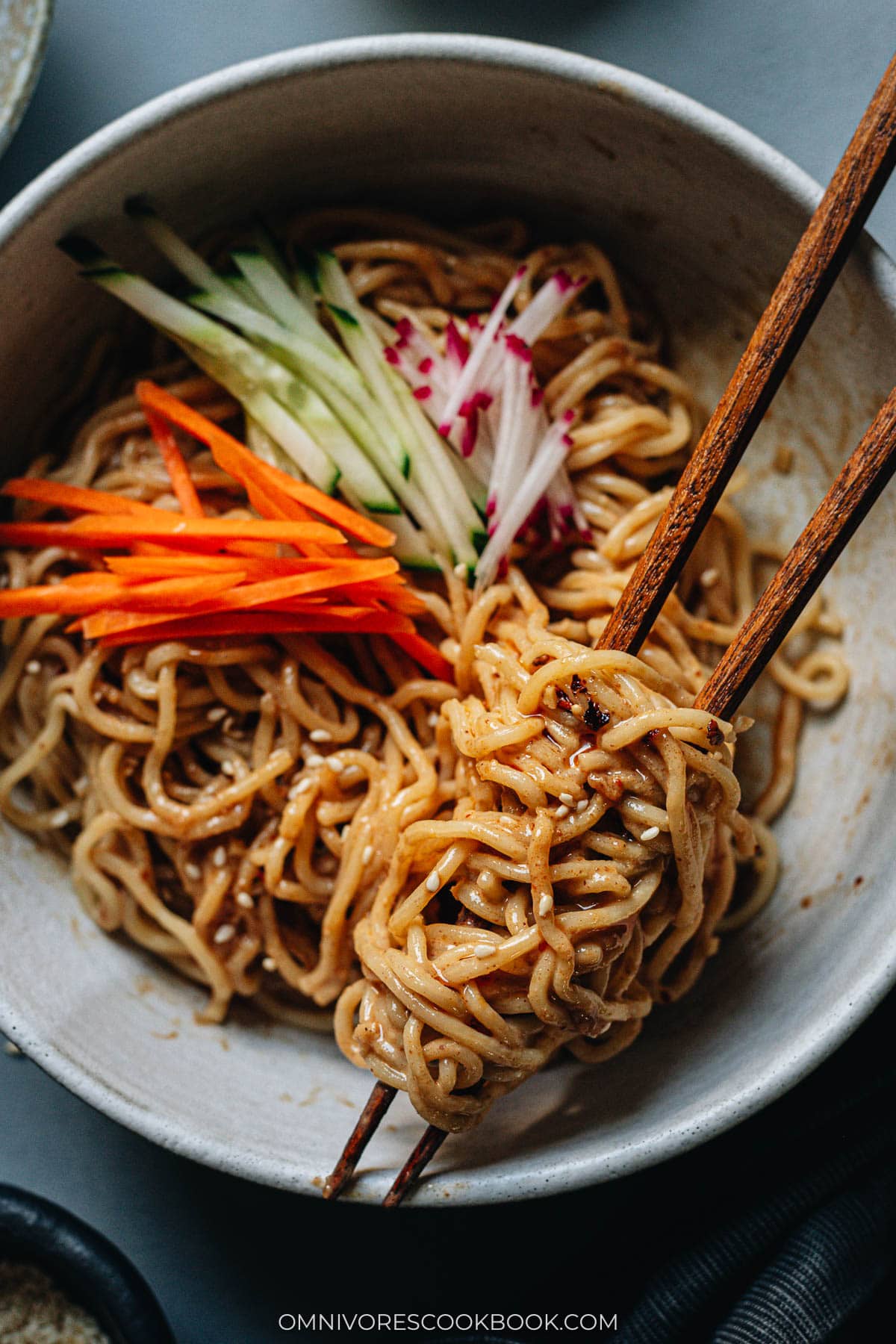
Sesame Noodles: A Symphony of Flavor
Sometimes I hear complaints that Chinese recipes tend to have super long ingredient lists, which scare people away. I couldn’t agree more. The fact is that Chinese cuisine is really good at playing with flavors. It brings together herbs, fermented sauces, and many ingredients that are sweet, salty, sour, and nutty to play a symphony. The tones and rhythms all come together, to create a beautiful melody. Everything is balanced, without a single ingredient jumping out or screaming loudly, just like an Authentic Chinese noodle recipe should be.
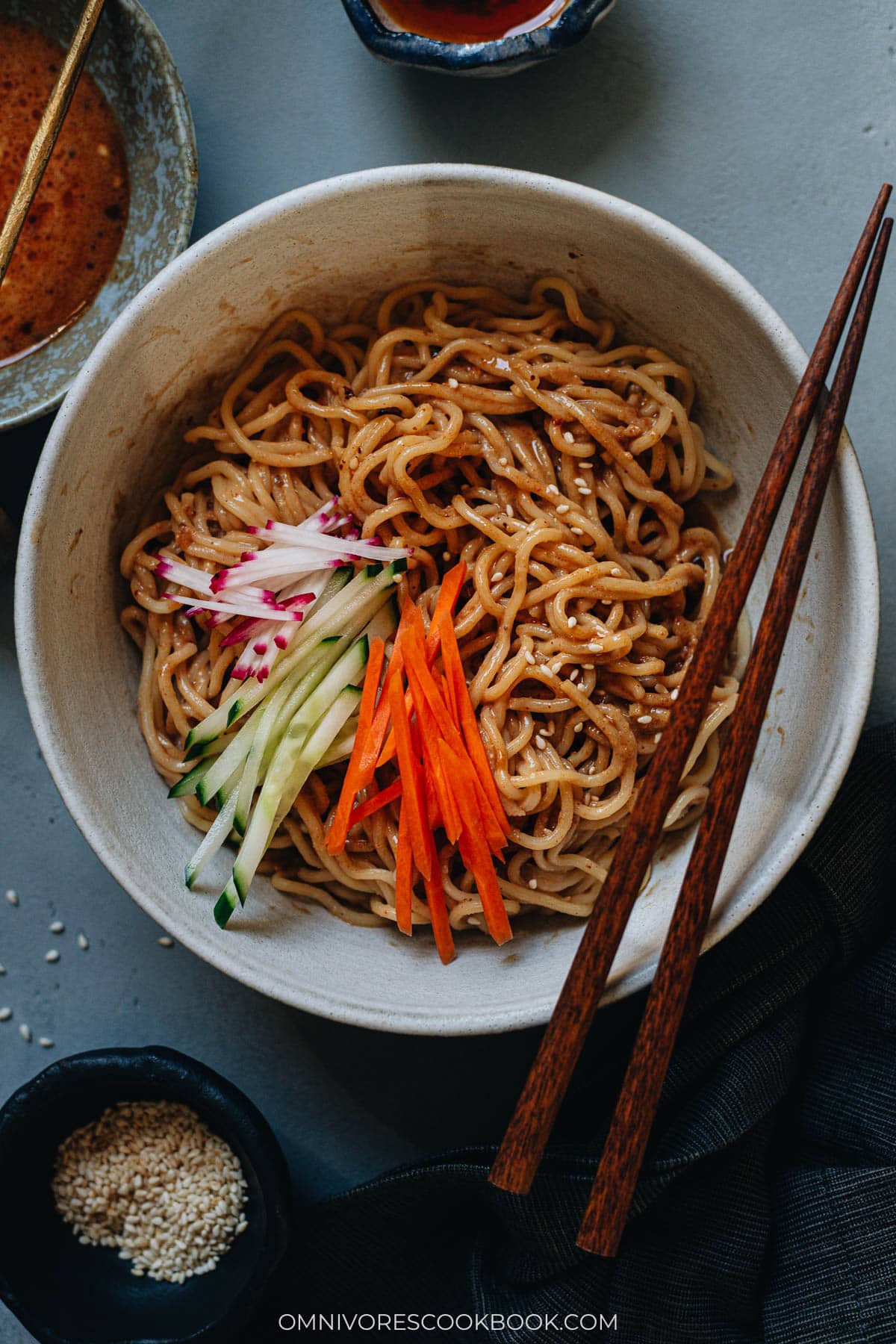
A Lot of Ingredients, Very Easy to Make
For “poor folks’ food” like noodles, the idea is to use the cheapest ingredients to maximize flavor. The goal is to make you happy with a stomach full of noodles, vegetables, and a minimal amount of meat (or no meat at all). A simple sesame noodle dish requires more than 10 ingredients to achieve this goal. In fact, if you count the ingredients needed to make the chili oil, you’ll need about 20 in total.
Sometimes I try to simplify recipes as much as I can, so you can actually make them at home. But in this case, I’d say you need the whole set of ingredients if you want the sauce to be interesting and not just taste like peanut butter.
Ingredients
- Sesame paste
- Light soy sauce
- Chinkiang vinegar
- Maple syrup
- Chili oil
- Sesame oil
- Ginger
- Garlic
- Sichuan peppercorns
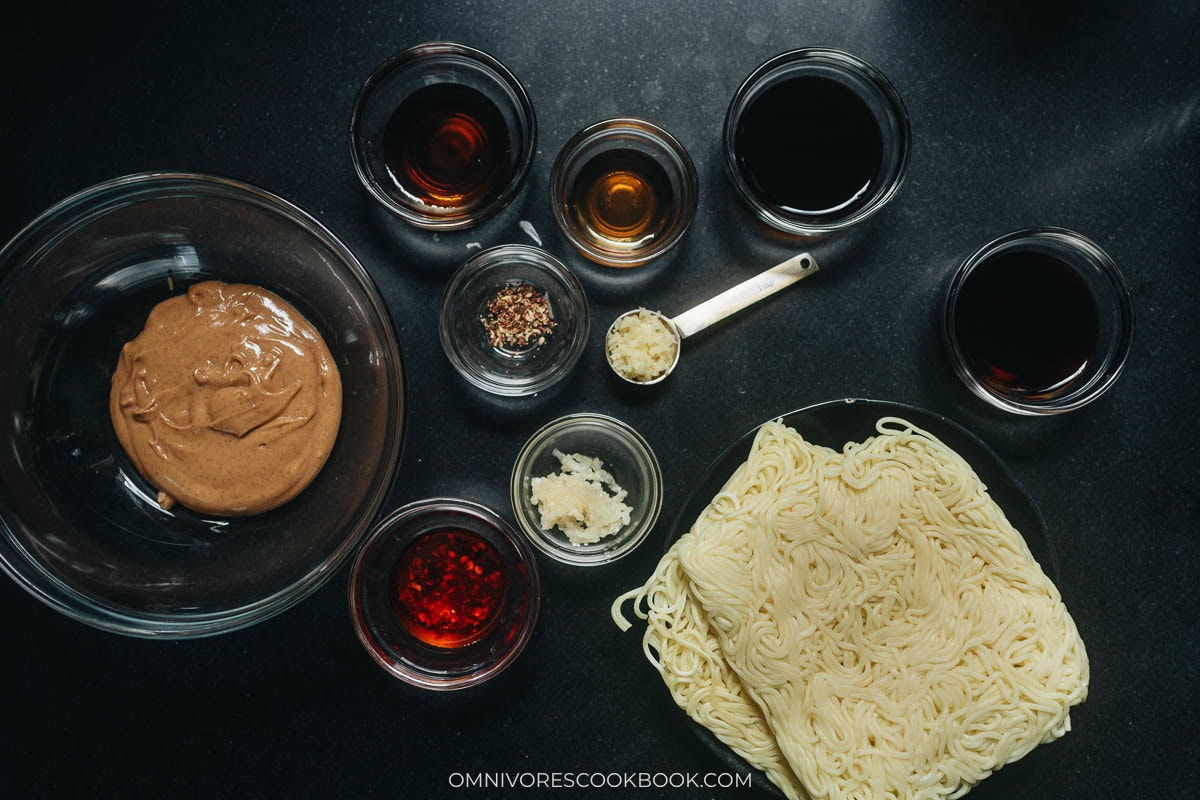
How to make sesame noodles
Making sesame noodles is extremely easy. Because all you need to do is mix the sauce, boiled the noodles, and mix everything together. But here some tips to help you make a better dish:
Mixing the sesame paste with liquid ingredients first: By slowly adding liquid ingredients and mixing them into the sesame paste, it’s very easy to make a thinned out smooth sauce without too much whisking.
Make sure to rinse and drain the noodles once cooked: Boiled noodles release starch. It’s important to rinse the noodles over cold running tap water to rinse off the starch, so the noodles strands separated properly. This way, the noodles have a much nice texture after mixing with the sauce. If you skip the rinsing step, the noodles will clump together and taste gummy after mixing with the sauce.
The Sesame Noodle Sauce isn’t Just for Noodles!
The flip side is that you can make more sauce ahead of time, store it in the fridge, and serve it during the week. For example,
- This sauce makes a very nice vegetable dip.
- It is also a great sauce for zucchini noodles.
- You can use it on roast chicken or leftover meat to make it more interesting.
- And you can thin it out a bit with water and use it as a salad dressing.
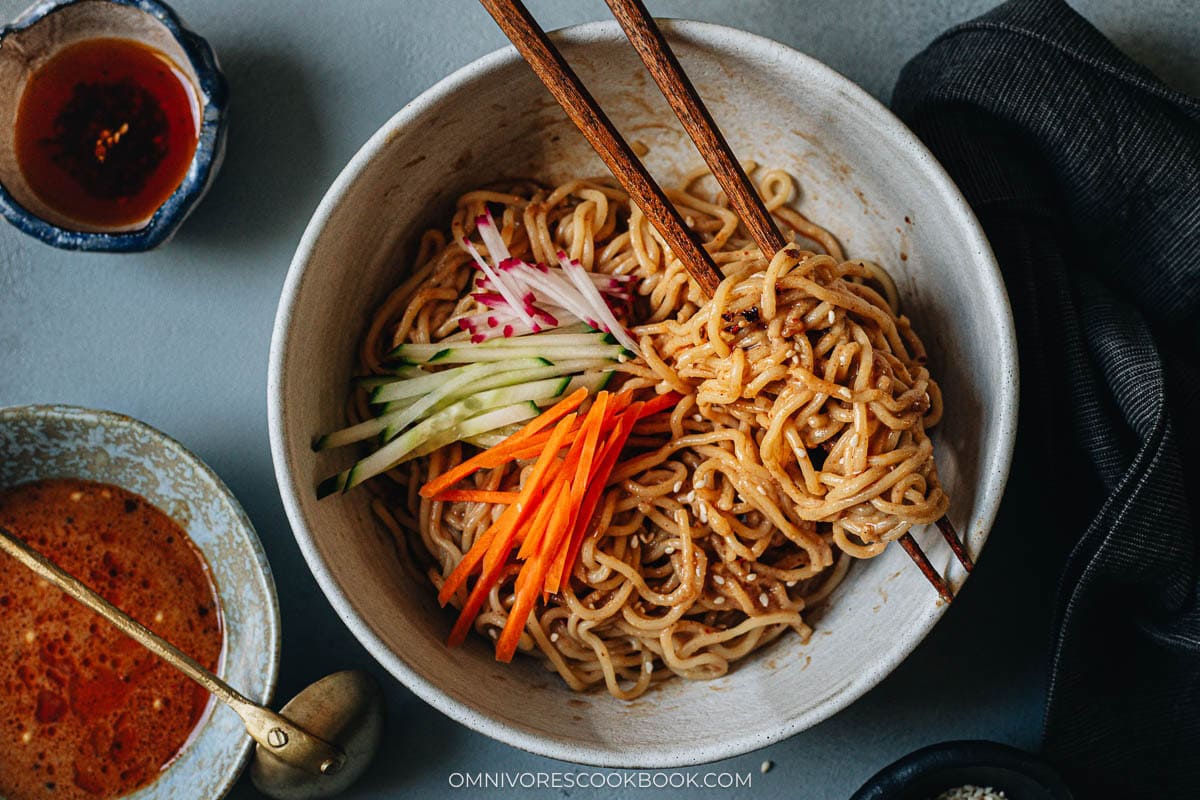
Make Your Own Chili Oil if You Can
The secret ingredients in this recipe are the homemade chili oil and roasted Sichuan peppercorn powder. When I serve this dish at cooking classes and events, I always sneak these two in there so that the noodles will wow everyone. With these ingredients, you can turn “just your average sesame noodles” into “OMG this is so good”.
That being said, if you want to use store-bought chili oil, use Lao Gan Ma (The Godmother Brand) or the Mala Market Chili Oil. Both taste great.
How to Serve Sesame Noodles
You can serve sesame noodles either as an appetizer or a main dish. They are easy to prepare ahead of time and the sauce only gets better after it has been in the fridge a few hours. I might skip (or use very minimal) toppings on the noodles to keep them simple as an appetizer. On the other hand, you can add other things to make it a full meal. For example, leftover shredded meat, sliced avocado, eggs (boiled, poached, or fried), and more vegetables. In this case, make more sauce accordingly.
Consider to use these toppings on sesame noodles:
- Instant Pot Shredded Chicken
- Crispy Tofu with Garlic Sauce (Skip the garlic sauce and use the sesame sauce instead)
- Chinese Braised Beef Shank
- 3-Ingredient Fried Shrimp
- Pickled Daikon with Carrot
Better Too Much Sauce Than Too Little
The last thing I want to emphasize is to always make more sauce than you expect you’ll need. The problem with noodle salad is that you never get the exact amount of sauce correct. Every type and brand of noodles absorbs water and sauce in a different rate. Plus, you might want a bit of extra sauce on the side. The sauce in this recipe is plenty for two big servings or four small servings. But you won’t regret making a double batch in any case.
I hope you enjoy!
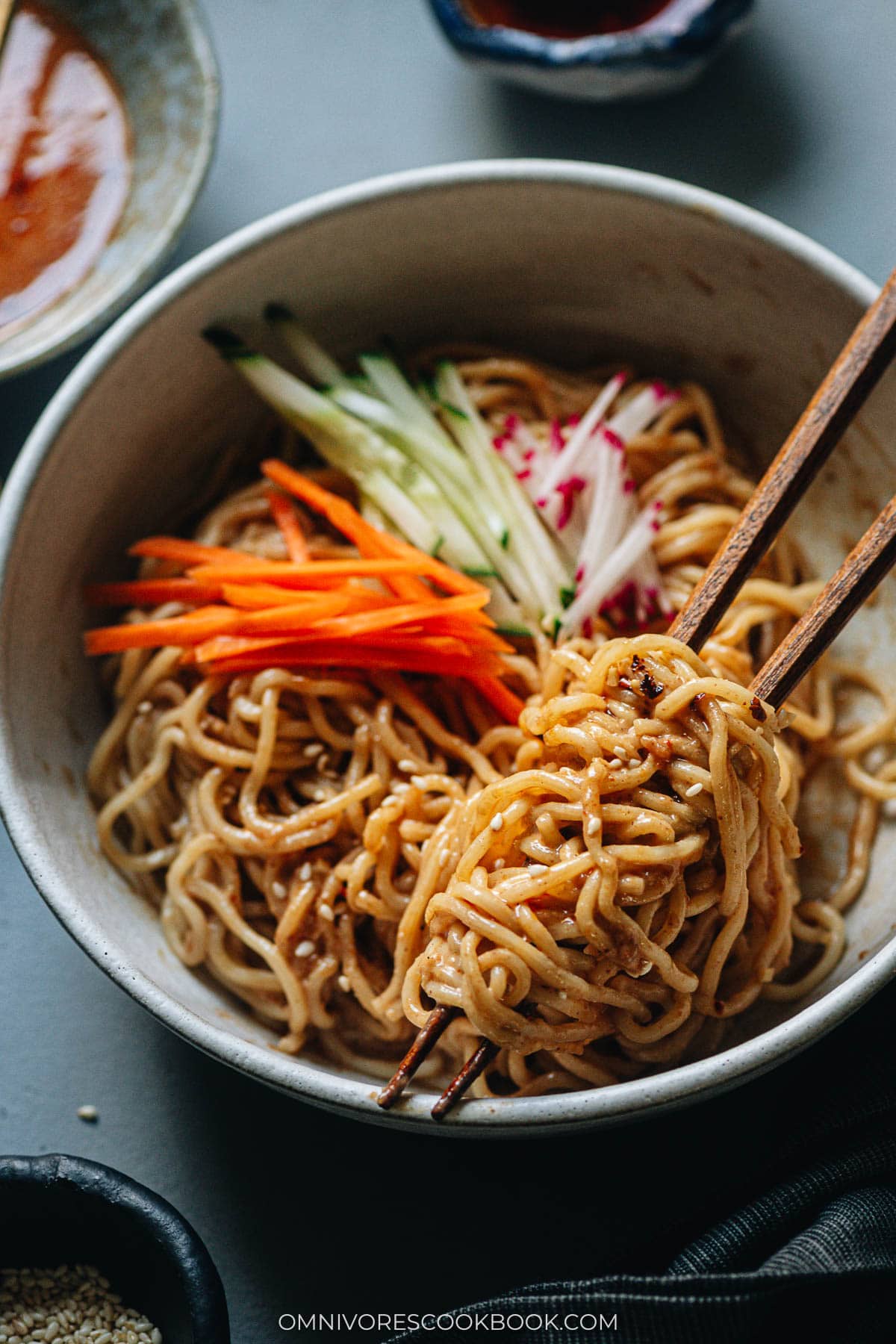
Chinese Cooking Made Easy
Are you new to this website? This free email series is a great place to start. I’ll walk you through a few of my most popular recipes and show you how and why they work. You’ll quickly start to cook better Chinese food in your own kitchen.
Watch video
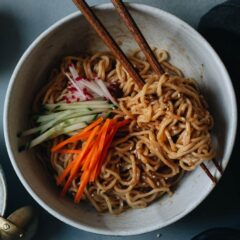
Real Deal Sesame Noodles
Ingredients
- 9 oz dried wheat noodles , or 1 pound (450 g) fresh wheat noodles (*Footnote 1)
Sauce
- 1/4 cup Chinese sesame paste (or unsalted natural peanut butter)
- 2 to 4 tablespoons warm water
- 2 tablespoons light soy sauce (or soy sauce)
- 2 tablespoons Chinkiang vinegar
- 1 tablespoon maple syrup (or sugar)
- 2 teaspoons homemade chili oil (or to taste) (*Footnote 2)
- 1 teaspoon sesame oil
- 1 teaspoon ginger , minced
- 2 cloves garlic , grated
- 1/8 teaspoon freshly ground Sichuan peppercorn powder
Topping options
- Cucumber , cut into thin strips (carrot and / or radish)
- Toasted sesame seeds for garnish
Instructions
- Add Chinese sesame paste to a medium size bowl and slowly add 2 tablespoons water, a little at a time. Stir with a spatula until the water is fully incorporated and it forms a smooth paste.
- One liquid ingredient at a time, add light soy sauce, Chinkiang vinegar, maple syrup, chili oil, and sesame oil, fully stir to incooperate each ingredient before adding the next one.
- Add the ginger, garlic, and Sichuan peppercorn powder. Stir to mix well. You can make the sauce ahead of time and store it in the fridge for 2 to 3 days.
- Boil noodles according to instructions. Transfer cooked noodles into a colander, rinse with tap water to stop the cooking. Drain well and transfer to small serving bowls.
- Serve the noodles with the sauce on the side with toppings of your preference.
- To eat, assemble your own bowl with any toppings you prefer, add a few spoonsful of the sauce. Mix and enjoy.
Notes
- The sauce in this dish is so flavorful and versatile that you can use many types of wheat noodles for a great result. For a traditional taste, try out lo mein noodles. Udon noodles and somen noodles work great as well.
- The homemade chili oil is usually served separately and added according to personal taste. I personally prefer to use a small amount in the sauce because it adds a very fragrant umami that makes the sauce stand out. Always ask your guests if they can handle a bit spiciness. If not, serve the chili oil separately with the noodles.
- The quantity of the sauce and noodle depend on many factors such as how many toppings you use, the type of noodles, and personal taste. The recipe is a good starting point that can general 2 big servings with some fresh produce toppings. Double the sauce if you plan on using more toppings.
Nutrition

Did you make this recipe?
I’d love to hear how it turned out for you! Please take a moment to leave a 5-star rating ⭐️ and share your thoughts in the comments further down the page. It really helps others discover the recipe too.

Rose
Can’t wait to make this! Random question: what is the purpose is of adding the sauce ingredients slowly/one at a time? I’m new to Chinese cooking and I’ve made a couple noodle dishes similar to this, and I usually just pour them all in and then stir. Just curious 🙂
Maggie Zhu
It just makes the sesame paste slightly easier to blend in the liquid and get a smooth texture. It is totally fine to pour everything in, but sometimes I found it might take a bit longer to mix and there might be small pieces of undissolved sesame paste floating around.
Deanna
This recipe is so easy with flavor that is wow! I served with teriyaki sesame salmon!
Question : can the left over sauce be frozen for another day?
Maggie Zhu
The sauce stays well in the fridge for a couple of days. If you want to store it longer, you can also freeze it.
Laura
These are delicious. I made extra sauce & it’s great for dipping veggies. Also put the chili oil on meat, grilled eggplant… so versatile. Thank you!
eileen
I made the noodles it is super easy & super Yummy.
Thanks so much.
Lavanya
This might just be my new favourite thing to make, the sauce was so easy to whip up and was so amazingly creamy
That with the chilli oil -I used Chiu chow chilli oil, so extra flavour bomb- it was so satisfying
Thank you for sharing!
Philip
You may want to update your links to your Chili Oil, since the links on this page are 404, not found.
RB
This was great and tasted just like my favorite Szechuan place! I did make a few substitutions because of what I have on the cabinet, but will be making it again.
1)recipe had ingredients of sugar or Maple syrup, but instructions said honey. I used Maple syrup (pure, unsweetened) since it was the easiest to stir. Doesn’t taste like Maple at all, just gently sweet.
2) used peanut butter instead of sesame paste, black sesame seeds instead of white, and used red pepper flakes I stead of the chili oil. I will try and make the chili oil another time.
Topped it will chopped scallion, shredded carrots, and Napa cabbage.
3) used 6 oz noodles for sauce, so it was saucy.
It was great!
Adriana D
Delicious! Going in our permanent rotation. We used peanut butter and Chili Garlic Sauce instead of Chili Oil. (I definitely WILL be making a batch of chili oil for next time) I usually do not care for peanut butter but in this capacity it is fantastic. I ended up adding more soy to my taste. Made one and a half batches of the sauce and it fed my family of five. For toppings we had thinly sliced blanched carrots, slivered cucumber, and cooked chopped chicken thighs. Perfect summer noodle dish!
Janine
These are the bomb! So delicious. Thanks!
April
I just made this and it is delicious! I had to make some substitutions: roasted sesame tahini, chili crisp instead of chili oil, a mixture of balsamic and rice vinegar. I also used coconut sugar. I’m eating it topped with grilled chicken thighs and cucumber. Yum!
Ed
I made this last night after shocking myself to find that my cupboard had every ingredient called listed. The only noodles I had around were linguine so said what the hay and used them. I made enough that I would have leftovers. Hah. I ate them all! Really good
Crabtownc
I’m not sure why readers have to post that they want to try a recipe. I’m reading the comments to find out how they liked it, or what didn’t work or was especially good. Please consider posting AFTER you’ve tried the recipe!dd
Linda
Would tahini be an acceptable replacement for sesame paste or peanut butter? This looks absolutely delicious and I can’t wait to try it. Thank you so much for the exceptional recipes you share with us.
Maggie Zhu
You definitely can. The flavor will be different but the sauce should be very tasty!
Kora
This is insanely tasty! One of our new favourites, especially for summer! Could eat it on a daily basis! Replaced the honey with agave and skipped Sichuan peppercorn powder, still so good! Thank you! 🙂
Valigator
Fantastic recipe, thank you!
My first batch was made with cashew butter (peanut allergies in the house) and was pretty delicious, although not as good as later batches with the legit sesame paste. And although this recipe is really really good as-is, I find that adding 1-2T of shiro miso just brings the sauce to a whole ‘nother level. And although it’s not traditional, it bridges some of the flavor profile gaps between the high vinegar tanginess and the low savory nuttiness, making the overall dish taste more balanced and rounded if that makes any sense.
Chloe
Is there much difference between tahini and Chinese sesame paste?
Maggie Zhu
The Chinese sesame paste uses toasted sesame seeds vs. tahini often use raw sesame seeds, so the un-toasted tahini usually has a grassy taste and different flavor profile. Although I heard there’s roasted tahini available (the type that has deep brown color) but so far I haven’t found them in regular grocery stores. I think the toasted tahini might taste very similar to Chinese sesame paste.
Jon
When I have had this dish on the mainland the carrots have been blanched and then rapidly cooled in an ice bath or running cold water.
This softens them, your recipe doesn’t really say whether or not to do so. This helps the carrots to mix into the noodles easier, and makes them easier to eat with chopsticks or fork as they’ll have a similar texture to the cucumber. i have also had this dish often mixed with ham strips also. Half peanut butter and half Tahini can also makes a more authentic flavor than just PB alone. IMHO.
Momo
These were great for a quick weeknight meal. I bought some fresh noodles from the asian grocery store and when I got home I realized that the instructions were in only in Korean! (I am Indian… lol) Luckily I guessed based off some numbers and pictures and it all came out great. Extra props to using my new julienne peeler for the garnish. Well worth it, and looks super professional for a home-cooked meal. I even had leftover sauce after feeding myself and my partner so I was able to whip up a quick meal a day later.
Theresa
This recipe is amazingly good! We make it with one part organic peanut butter and one part black sesame paste, and all other ingredients the same. Your recipe for chili oil is great on these noodles also. I’ve made it with lightly stir fried veggies, even kale! Keep up the great work!
Colleen
Aloha Maggie
There is a Chinese noodle factory / store near my home. What kind of fresh noodle would you recommend that I order to make the Sesame noodle dish.
Can’t wait to try your recipe.
Colleen